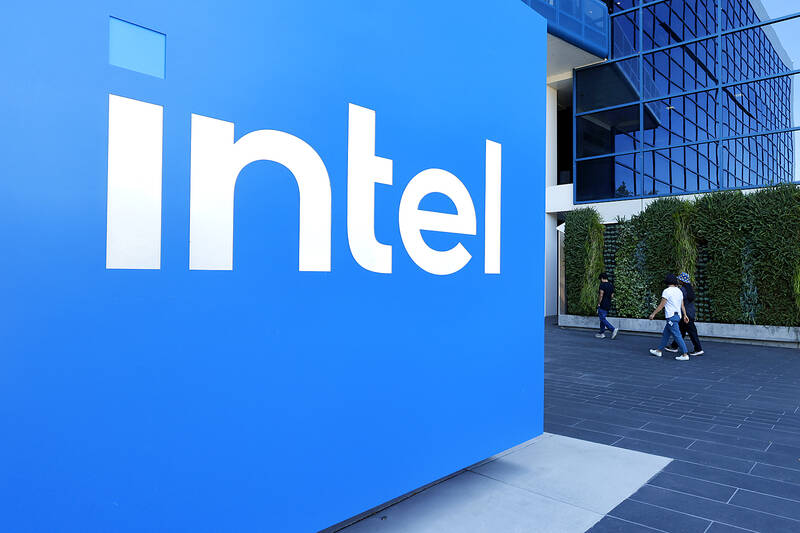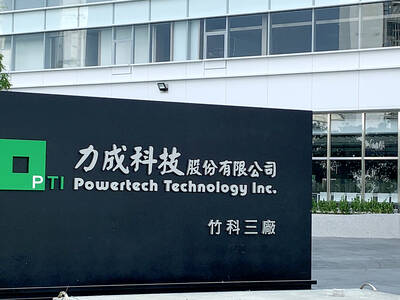Intel Corp, the embattled chipmaker now backed by the US government, has introduced new products and manufacturing technology that are central to its turnaround bid.
The company on Thursday announced that its Panther Lake processor designs are in full production and are to go on sale in laptops early next year. The new chips are made with 18A technology, which Intel says offers advantages that none of its competitors can yet match.
The unveiling follows a furious six-month stretch for Intel chief executive officer Lip-Bu Tan (陳立武). After taking the job in mid-March, he has tried to shake up Intel, while also seeking outside help.

Photo: EPA
The US government has become the chipmaker’s biggest investor as part of an unconventional deal brokered by the White House, while Nvidia Corp and SoftBank Group Corp have acquired multibillion-dollar stakes.
Although the dealmaking has lifted Intel’s stock price, the company still needs to show that new products would win back lost market share and attract customers to its foundry division — a business that makes chips for outside clients.
The Panther Lake design builds on its predecessors’ strengths and eliminates their shortcomings, Intel executives said at a company event in Arizona.
The processors would more readily balance a PC’s need to run demanding software, such as artificial intelligence (AI) models, without rapidly draining batteries.
Intel executives explained the benefits of their latest offerings in presentations hosted near a new factory at its Ocotillo site in Arizona. Known as Fab 52, the facility is the first to go into mass production with the 18A technique.
The once-dominant chipmaker is suffering through its second year of losses, and analysts do not expect a return to profitability before 2027. That slump reflects a dramatic drop in revenue — triggered by market-share declines and a failure to capitalize on surging demand for AI chips in data centers. By getting the jump on Intel in AI, Nvidia has become the industry’s dominant player.
Intel is also shouldering the costly burden of trying to update its factories. Fab 52 alone required more steel than the Eiffel Tower to build and contains machines that cost hundreds of millions of US dollars each.
Over three days of presentations at the event, Intel executives repeatedly asserted that 18A is the most advanced chip production technology developed and deployed in the US. That made-in-the-US spirit lines up with a government push to bolster domestic manufacturing and reduce reliance on factories in East Asia.
The company can make 18A-equipped factories pay for themselves by producing chips for its own needs, Intel said, but the next phase, a technology called 14A, would require outside customers and a high volume of orders to be cost-effective.
Getting the new 18A chips to market, in products that demonstrate better performance for consumers, would be the first step toward re-establishing Intel’s credibility, Intel foundry business general manager Kevin O’Buckley said.

RUN IT BACK: A succesful first project working with hyperscalers to design chips encouraged MediaTek to start a second project, aiming to hit stride in 2028 MediaTek Inc (聯發科), the world’s biggest smartphone chip supplier, yesterday said it is engaging a second hyperscaler to help design artificial intelligence (AI) accelerators used in data centers following a similar project expected to generate revenue streams soon. The first AI accelerator project is to bring in US$1 billion revenue next year and several billion US dollars more in 2027, MediaTek chief executive officer Rick Tsai (蔡力行) told a virtual investor conference yesterday. The second AI accelerator project is expected to contribute to revenue beginning in 2028, Tsai said. MediaTek yesterday raised its revenue forecast for the global AI accelerator used

Taiwan Semiconductor Manufacturing Co (TSMC, 台積電) has secured three construction permits for its plan to build a state-of-the-art A14 wafer fab in Taichung, and is likely to start construction soon, the Central Taiwan Science Park Bureau said yesterday. Speaking with CNA, Wang Chun-chieh (王俊傑), deputy director general of the science park bureau, said the world’s largest contract chipmaker has received three construction permits — one to build a fab to roll out sophisticated chips, another to build a central utility plant to provide water and electricity for the facility and the other to build three office buildings. With the three permits, TSMC

The DBS Foundation yesterday announced the launch of two flagship programs, “Silver Motion” and “Happier Caregiver, Healthier Seniors,” in partnership with CCILU Ltd, Hondao Senior Citizens’ Welfare Foundation and the Garden of Hope Foundation to help Taiwan face the challenges of a rapidly aging population. The foundation said it would invest S$4.91 million (US$3.8 million) over three years to foster inclusion and resilience in an aging society. “Aging may bring challenges, but it also brings opportunities. With many Asian markets rapidly becoming super-aged, the DBS Foundation is working with a regional ecosystem of like-minded partners across the private, public and people sectors

BREAKTHROUGH TECH: Powertech expects its fan-out PLP system to become mainstream, saying it can offer three-times greater production throughput Chip packaging service provider Powertech Technology Inc (力成科技) plans to more than double its capital expenditures next year to more than NT$40 billion (US$1.31 billion) as demand for its new panel-level packaging (PLP) technology, primarily used in chips for artificial intelligence (AI) applications, has greatly exceeded what it can supply. A significant portion of the budget, about US$1 billion, would be earmarked for fan-out PLP technology, Powertech told investors yesterday. Its heavy investment in fan-out PLP technology over the past 10 years is expected to bear fruit in 2027 after the technology enters volume production, it said, adding that the tech would